重型颅脑损伤处理流程
重度颅脑损伤患者应急预案及流程
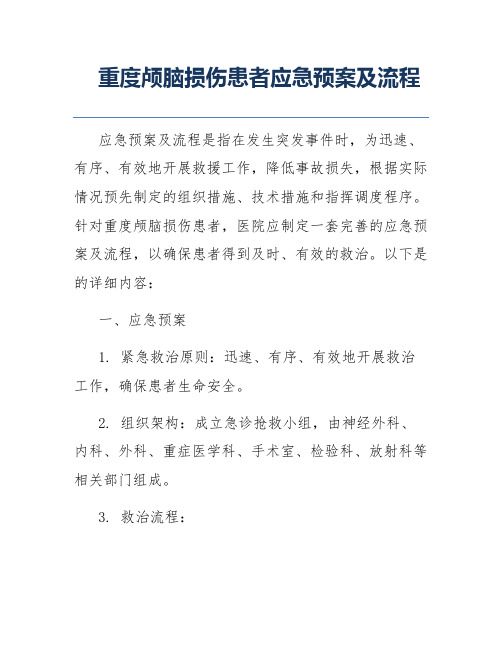
重度颅脑损伤患者应急预案及流程应急预案及流程是指在发生突发事件时,为迅速、有序、有效地开展救援工作,降低事故损失,根据实际情况预先制定的组织措施、技术措施和指挥调度程序。
针对重度颅脑损伤患者,医院应制定一套完善的应急预案及流程,以确保患者得到及时、有效的救治。
以下是的详细内容:一、应急预案1. 紧急救治原则:迅速、有序、有效地开展救治工作,确保患者生命安全。
2. 组织架构:成立急诊抢救小组,由神经外科、内科、外科、重症医学科、手术室、检验科、放射科等相关部门组成。
3. 救治流程:(1)接诊:接到患者后,立即对患者进行生命体征评估,判断病情危重程度。
(2)初步诊断:根据患者病史、症状、体征及辅助检查结果,初步判断为重度颅脑损伤。
(3)紧急处理:立即为患者建立静脉通道,给予吸氧、心电监护、血压监测等支持治疗。
(4)术前准备:通知神经外科医生,做好手术前准备。
(5)转科:将患者迅速转至神经外科重症监护室。
4. 救治措施:(1)神经外科:负责患者手术治疗、术后监护及并发症处理。
(2)内科、外科:协助神经外科进行术前准备,提供相关学科支持。
(3)重症医学科:负责患者术后重症监护,确保患者生命体征稳定。
(4)检验科、放射科:及时为患者提供血液、影像学等检查,为诊断和治疗提供依据。
二、流程图以下是重度颅脑损伤患者应急预案流程图:[接诊] -- [初步诊断] -- [紧急处理] -- [术前准备] -- [转科] -- [神经外科手术治疗] -- [术后监护] -- [重症医学科监护] -- [检验科、放射科检查] -- [治疗结束]三、注意事项1. 提高接诊意识:接诊医生应具备高度的责任心和敏锐的洞察力,对疑似重度颅脑损伤患者进行迅速判断。
2. 密切配合:各部门应密切合作,确保救治工作顺利进行。
3. 病情观察:严密观察患者生命体征、意识状态、瞳孔变化等,及时发现并处理病情恶化。
4. 家属沟通:向患者家属解释病情、治疗方案及可能的风险,取得家属的理解和支持。
简述重度颅脑损伤患者急诊流程
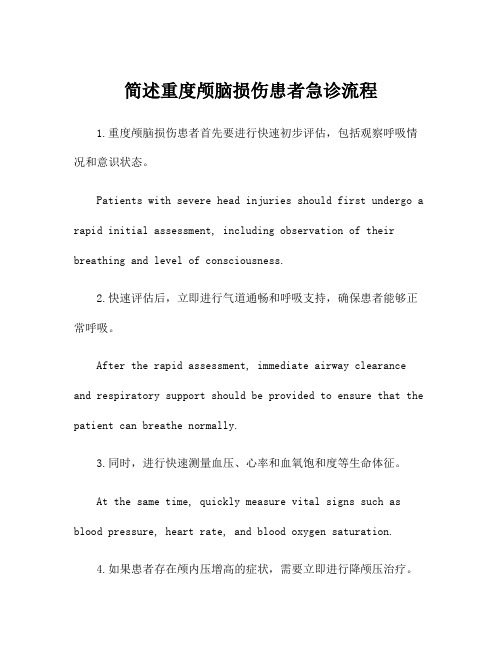
简述重度颅脑损伤患者急诊流程1.重度颅脑损伤患者首先要进行快速初步评估,包括观察呼吸情况和意识状态。
Patients with severe head injuries should first undergo a rapid initial assessment, including observation of their breathing and level of consciousness.2.快速评估后,立即进行气道通畅和呼吸支持,确保患者能够正常呼吸。
After the rapid assessment, immediate airway clearance and respiratory support should be provided to ensure that the patient can breathe normally.3.同时,进行快速测量血压、心率和血氧饱和度等生命体征。
At the same time, quickly measure vital signs such as blood pressure, heart rate, and blood oxygen saturation.4.如果患者存在颅内压增高的症状,需要立即进行降颅压治疗。
If the patient shows signs of increased intracranial pressure, immediate treatment to reduce the pressure should be initiated.5.迅速进行头部CT检查,以确认颅内出血和其他损伤类型。
Quickly perform a head CT scan to confirm intracranial bleeding and other types of damage.6.结合临床表现和影像检查结果,医生需要尽快确定患者的颅脑损伤程度。
重型颅脑损伤抢救流程
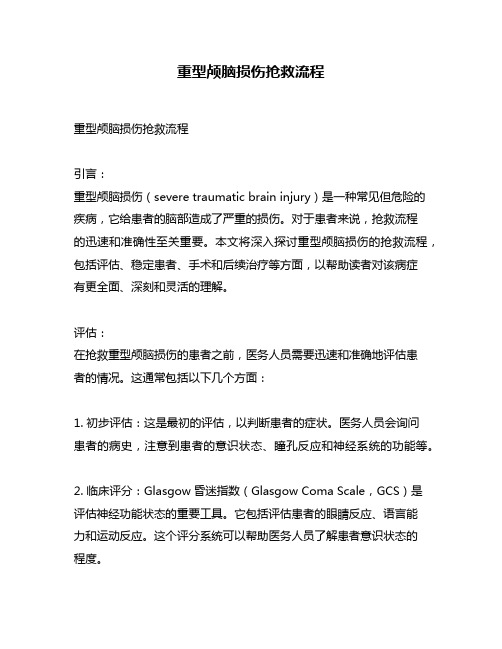
重型颅脑损伤抢救流程重型颅脑损伤抢救流程引言:重型颅脑损伤(severe traumatic brain injury)是一种常见但危险的疾病,它给患者的脑部造成了严重的损伤。
对于患者来说,抢救流程的迅速和准确性至关重要。
本文将深入探讨重型颅脑损伤的抢救流程,包括评估、稳定患者、手术和后续治疗等方面,以帮助读者对该病症有更全面、深刻和灵活的理解。
评估:在抢救重型颅脑损伤的患者之前,医务人员需要迅速和准确地评估患者的情况。
这通常包括以下几个方面:1. 初步评估:这是最初的评估,以判断患者的症状。
医务人员会询问患者的病史,注意到患者的意识状态、瞳孔反应和神经系统的功能等。
2. 临床评分:Glasgow昏迷指数(Glasgow Coma Scale,GCS)是评估神经功能状态的重要工具。
它包括评估患者的眼睛反应、语言能力和运动反应。
这个评分系统可以帮助医务人员了解患者意识状态的程度。
3. 影像学评估:对于重型颅脑损伤的患者,常常需要进行脑部CT扫描或MRI来确定损伤的程度和位置。
这些影像学评估可以帮助医务人员做出更准确的诊断和治疗计划。
稳定患者:在评估完患者状况后,医务人员需要采取措施稳定患者的病情,防止进一步损伤。
以下是一些常见的稳定措施:1. 维持呼吸通畅:患者可能会出现呼吸困难或氧气供应不足的情况。
医务人员应确保患者的气道通畅,并提供足够的氧气供应。
2. 控制颅内压:重型颅脑损伤可能导致颅内压增高,进而引发脑水肿。
医务人员可以采用药物治疗或使用颅内压监测装置,监测和控制颅内压。
3. 液体管理:在患者的稳定过程中,医务人员需要维持患者的液体平衡。
这包括适当的输液和监测液体摄入和排出。
手术:对于某些重型颅脑损伤的患者,可能需要进行手术治疗来减轻脑部损伤。
以下是常见的手术治疗方法:1. 颅内压监测:通过在患者头部植入颅内压监测装置,医务人员可以实时监测患者的颅内压情况。
这有助于及时调整治疗方案以避免进一步损伤。
重型颅脑伤应急预案

一、背景与目的重型颅脑伤是指因交通事故、跌落、打击等原因导致的严重颅脑损伤,患者病情危重,具有极高的病死率和致残率。
为提高重型颅脑伤的救治效率,保障人民群众的生命安全,特制定本应急预案。
二、组织机构与职责1. 成立重型颅脑伤应急指挥部,负责应急工作的组织、指挥和协调。
2. 应急指挥部下设以下工作组:- 信息报送组:负责收集、汇总、上报重型颅脑伤相关信息。
- 医疗救治组:负责伤员的救治工作,包括现场急救、转运、医院救治等。
- 后勤保障组:负责应急物资的储备、调配和供应。
- 宣传报道组:负责应急工作的宣传报道,提高公众对重型颅脑伤的认识和应对能力。
三、应急响应流程1. 信息报告:发现重型颅脑伤病例后,立即向应急指挥部报告。
2. 启动预案:应急指挥部接到报告后,立即启动应急预案,通知相关工作组进入应急状态。
3. 现场急救:医疗救治组迅速到达现场,对伤员进行初步评估和急救处理。
4. 转运伤员:根据伤员情况,选择合适的交通工具和转运路线,确保伤员安全、快速地转运至医院。
5. 医院救治:医院接到伤员后,立即进行抢救,并根据伤员病情制定治疗方案。
6. 信息跟踪:应急指挥部持续跟踪伤员救治情况,及时向相关部门和领导汇报。
四、应急保障措施1. 物资储备:应急指挥部负责储备足够的急救药品、医疗器械、救护车辆等物资。
2. 人员培训:定期组织相关人员进行急救知识和技能培训,提高应急处置能力。
3. 通讯保障:确保应急指挥系统和各工作组通讯畅通,提高信息传递效率。
4. 联动机制:加强与公安、消防、交通等部门的联动,形成应急救援合力。
五、应急总结与评估1. 应急结束后,应急指挥部组织对本次事件进行总结和评估,分析原因,总结经验,完善应急预案。
2. 对参与应急工作的单位和个人给予表彰和奖励,对工作中存在的问题进行整改。
本预案自发布之日起实施,如有需要,可根据实际情况进行调整。
重型颅脑损伤抢救流程
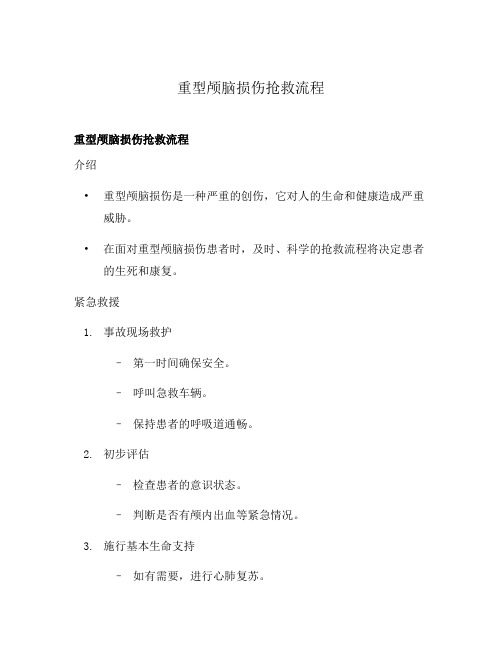
重型颅脑损伤抢救流程重型颅脑损伤抢救流程介绍•重型颅脑损伤是一种严重的创伤,它对人的生命和健康造成严重威胁。
•在面对重型颅脑损伤患者时,及时、科学的抢救流程将决定患者的生死和康复。
紧急救援1.事故现场救护–第一时间确保安全。
–呼叫急救车辆。
–保持患者的呼吸道通畅。
2.初步评估–检查患者的意识状态。
–判断是否有颅内出血等紧急情况。
3.施行基本生命支持–如有需要,进行心肺复苏。
–控制外伤性休克等并发症。
院前急救1.运送患者到医院–尽快将患者送往有神经外科和重症监护室的医院。
–在运送过程中,继续监测患者的生命体征。
急诊处理1.微创颅脑损伤筛查–通过CT扫描检查是否有颅内血肿等严重损伤。
–检查伤情严重程度,决定进一步处理方案。
2.颅内压监测–钻孔穿刺或置入颅内压监测装置,监测患者颅内压力的变化。
3.药物控制颅内压–通过使用利尿剂、血管紧张素转换酶抑制剂等药物,控制颅内高压。
4.头颅外科手术–如有需要,在最短时间内进行头颅外科手术,减轻颅内压力。
重症监护1.进一步观察–监测患者的生命体征和神经功能状态。
–定期进行颅脑CT扫描,了解损伤程度和治疗效果。
2.液体管理–维持患者体液平衡,防止脱水和低血容量状态。
–根据患者具体情况调整给予液体的种类和剂量。
康复治疗1.早期功能训练–开始早期的物理治疗和康复训练,促进患者康复。
–包括功能恢复、语言训练、认知训练等。
2.心理支持–对患者及其家属进行心理咨询和支持,帮助其面对和应对困难。
3.长期康复计划–制定长期康复计划,根据患者的康复进展进行调整。
–定期复查和评估,提供个性化的康复治疗方案。
结论•重型颅脑损伤的抢救流程是一个复杂而关键的过程,需要全面的团队合作和科学的处理方法。
•遵循以上流程,及时而有效地进行抢救和治疗,将提高患者的生存率和康复质量。
重型颅脑损伤抢救流程
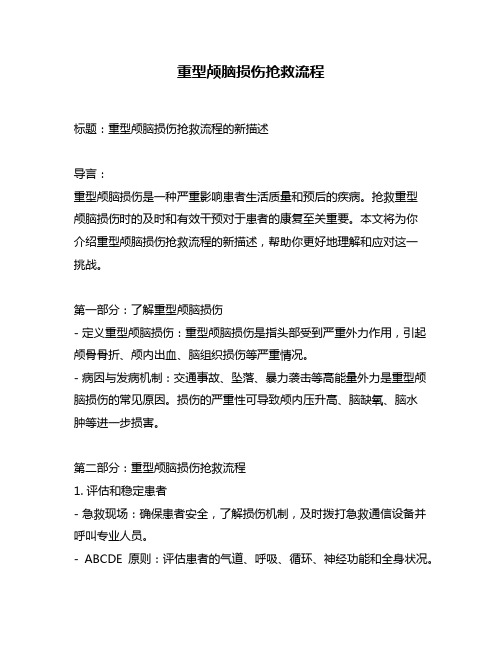
重型颅脑损伤抢救流程标题:重型颅脑损伤抢救流程的新描述导言:重型颅脑损伤是一种严重影响患者生活质量和预后的疾病。
抢救重型颅脑损伤时的及时和有效干预对于患者的康复至关重要。
本文将为你介绍重型颅脑损伤抢救流程的新描述,帮助你更好地理解和应对这一挑战。
第一部分:了解重型颅脑损伤- 定义重型颅脑损伤:重型颅脑损伤是指头部受到严重外力作用,引起颅骨骨折、颅内出血、脑组织损伤等严重情况。
- 病因与发病机制:交通事故、坠落、暴力袭击等高能量外力是重型颅脑损伤的常见原因。
损伤的严重性可导致颅内压升高、脑缺氧、脑水肿等进一步损害。
第二部分:重型颅脑损伤抢救流程1. 评估和稳定患者- 急救现场:确保患者安全,了解损伤机制,及时拨打急救通信设备并呼叫专业人员。
- ABCDE原则:评估患者的气道、呼吸、循环、神经功能和全身状况。
如有需要,进行气道通畅、呼吸支持和静脉通路建立等措施。
- 伤情评估:进行快速的初步伤情评估,包括神经系统评估和全身系统评估。
2. 确认诊断和开展必要检查- CT扫描:进行头颅CT扫描,以明确诊断、评估损伤程度、判断是否需要手术干预,并评估颅脑内血肿、骨折、脑挫裂伤等情况。
- 血液检查:包括常规血液检查、凝血功能评估和电解质检测等,以了解患者的全身情况。
3. 颅内压控制和脑灌注压维持- 颅内压监测:通过插入颅内压监测器,实时监测颅内压力的变化,以及依据监测结果调整治疗方案。
- 正常通气:保持患者通气正常,维持适当的氧合和二氧化碳排除,避免高碳酸血症,以降低颅内压。
4. 头颅外伤处理- 颅骨骨折处理:根据不同类型和程度的骨折,采用保守治疗或手术复位固定等方式恢复颅骨完整性。
- 外科手术:对于严重颅脑损伤伴有脑挫裂伤、脑血肿等情况,可能需要及早进行外科手术干预。
5. 脑水肿和颅内压的控制- 药物治疗:常用利尿剂、渗透剂和甘露醇等药物来减轻脑水肿和颅内压。
- 低温治疗:采用降温措施,通过降低颅内代谢率,减少脑组织对氧合的依赖,以降低颅内压。
重型颅脑损伤抢救流程专家讲座

重型颅脑损伤抢救流程专家讲座
第2页
颅脑损伤分类
1、轻型颅脑损伤:单纯脑震荡,昏迷时间<30分钟,轻度头痛、头晕症状。 神经系统及脑脊液检验无显著异常,有或无颅骨骨折, Giasgow2小时,生命体征有轻度改 变,有轻度神经系统症状,有或无颅骨骨折及蛛网膜 下腔出血,Giasgow计分为9~12分。
重型颅脑损伤抢救流程专家讲座
第3页
抢救流程
一、判断意识,问询、评定病情 二、测量生命体征,初步处理,深入了解病情 三、依据患者情况,按轻重缓急逐一处理 四、护送患者行相关检验、入病房/手术室,确保途中安全 五、按要求处理、补齐抢救用物,及时统计
重型颅脑损伤抢救流程专家讲座
第4页
一、判断意识,问询、评定病情
① 生命体征平稳
② 气道通畅,静脉输液通畅
③ 电话通知病房/手术室护士,通知患者性别,年纪,主要病情,方便 接收科室做好准备
④ 携带好抢救物品、药品,医护共同护送,确保途中安全
⑤ 与病房/手术室护士进行交接,填写患者交接单
重型颅脑损伤抢救流程专家讲座
第10页
五、按要求处理、补齐抢救用物,及时统计
1.用后抢救物品,按要求分类处理 2.及时补齐各类抢救物品,药品 3.按要求补写抢救统计
② 遵医嘱给予甘露醇250ml快速静滴,或呋塞米20mg静脉推注
③ GCS评分,汇报医生并统计,亲密观察病情
④ 遵医嘱深入检验治疗
评分 1
Giasgow昏迷计分(GCS)
运动反应
言语反应
无运动
无语言
睁眼反应 不睁眼
2
肢体伸直反应
仅能发音
疼痛睁眼
3
肢体屈曲反应
4
刺激肢体有回缩
重型颅脑伤应急预案

一、编制目的为有效应对重型颅脑伤的紧急情况,提高救治效率,降低患者死亡率,保障人民群众的生命安全,特制定本预案。
二、适用范围本预案适用于我院及所属分院在发生重型颅脑伤时的应急处理。
三、组织机构与职责1. 应急指挥部(1)总指挥:由院长担任,负责应急工作的全面领导。
(2)副总指挥:由副院长、相关科室负责人担任,协助总指挥开展工作。
(3)成员:各科室负责人、医护人员、行政人员等。
2. 医疗救治组(1)组长:由神经外科主任担任,负责伤员的医疗救治工作。
(2)成员:神经外科、急诊科、ICU等相关科室医护人员。
3. 护理保障组(1)组长:由护理部主任担任,负责伤员的护理工作。
(2)成员:各科室护士、护理部相关人员。
4. 后勤保障组(1)组长:由后勤保障部门负责人担任,负责伤员的物资、设备保障工作。
(2)成员:后勤保障部门相关人员。
5. 沟通协调组(1)组长:由医务科主任担任,负责与上级部门、其他医院的沟通协调工作。
(2)成员:医务科、行政科等相关人员。
四、应急处置流程1. 报告与启动(1)发现重型颅脑伤患者后,立即向应急指挥部报告。
(2)应急指挥部接到报告后,立即启动应急预案,各小组按照职责分工开展工作。
2. 医疗救治(1)医护人员迅速对患者进行初步评估,判断伤情。
(2)根据伤情,进行相应的急救措施,如心肺复苏、止血、固定等。
(3)将伤员迅速转运至抢救室,进行进一步救治。
3. 护理保障(1)护理人员负责伤员的生命体征监测、用药护理、伤口护理等。
(2)根据医嘱,协助医生进行各项检查、治疗。
4. 后勤保障(1)后勤保障部门负责提供急救药品、器械、设备等。
(2)确保伤员转运、救治过程中的物资供应。
5. 沟通协调(1)与上级部门、其他医院保持密切沟通,汇报伤员救治情况。
(2)协调相关科室、部门,确保救治工作顺利进行。
五、注意事项1. 各小组要严格按照预案要求,迅速、有序地开展工作。
2. 医护人员要充分发挥专业优势,全力以赴救治伤员。
重型颅脑损伤抢救流程

重型颅脑损伤是一种严重危及生命的疾病,其病情复杂多变,抢救的及时性和准确性至关重要。
科学、规范的抢救流程能够最大限度地提高患者的生存率和生存质量,减少并发症的发生。
本文将详细介绍重型颅脑损伤的抢救流程,以期为临床救治提供指导。
一、现场急救在重型颅脑损伤发生的现场,急救人员应迅速到达并立即展开抢救工作。
(一)初步评估1. 快速检查患者的意识状态,采用呼喊、拍打等方式判断患者是否清醒,若患者意识丧失,立即评估其呼吸、脉搏等生命体征。
2. 检查患者头部有无明显外伤,如头皮裂伤、血肿等。
3. 注意观察患者的瞳孔大小、对光反射情况,瞳孔的变化往往能提示颅内病情的变化。
(二)保持呼吸道通畅重型颅脑损伤患者常伴有呕吐、口腔分泌物增多等情况,若呼吸道不畅,易导致窒息,危及生命。
急救人员应立即清除患者口腔、鼻腔内的呕吐物、分泌物等,使呼吸道保持通畅。
对于舌根后坠的患者,可采用托起下颌、放置口咽通气道等方法。
若患者头部有明显出血,应立即进行止血处理。
可采用加压包扎、止血带等方法,但要注意止血的时间和力度,避免造成肢体缺血坏死。
(四)转运在现场急救初步处理完成后,应尽快将患者转运至医院进行进一步的救治。
转运过程中要保持患者头部固定,避免颠簸和震动,同时密切监测患者的生命体征。
二、急诊室接诊(一)接诊准备急诊室医护人员应提前做好接诊准备,包括准备好抢救设备和药品,如呼吸机、心电监护仪、止血药物、脱水药物等。
(二)快速评估患者到达急诊室后,医护人员应迅速进行快速评估。
1. 再次评估患者的意识状态、生命体征,了解病情的变化趋势。
2. 详细询问患者受伤的经过、时间、地点等情况,以便对病情进行全面了解。
3. 进行神经系统检查,包括瞳孔、肌力、肌张力、反射等,评估患者的神经功能状况。
根据患者的病情,进行以下初步处理:1. 建立静脉通道,快速输注生理盐水或平衡液,维持有效循环血量。
2. 给予吸氧,改善患者的缺氧状态。
3. 遵医嘱给予止血、脱水、降颅压等药物治疗。
重型颅脑损伤应急预案
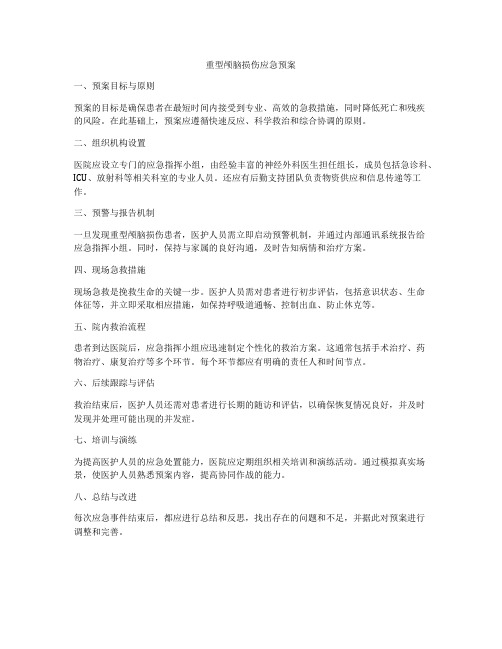
重型颅脑损伤应急预案
一、预案目标与原则
预案的目标是确保患者在最短时间内接受到专业、高效的急救措施,同时降低死亡和残疾
的风险。
在此基础上,预案应遵循快速反应、科学救治和综合协调的原则。
二、组织机构设置
医院应设立专门的应急指挥小组,由经验丰富的神经外科医生担任组长,成员包括急诊科、ICU、放射科等相关科室的专业人员。
还应有后勤支持团队负责物资供应和信息传递等工作。
三、预警与报告机制
一旦发现重型颅脑损伤患者,医护人员需立即启动预警机制,并通过内部通讯系统报告给
应急指挥小组。
同时,保持与家属的良好沟通,及时告知病情和治疗方案。
四、现场急救措施
现场急救是挽救生命的关键一步。
医护人员需对患者进行初步评估,包括意识状态、生命
体征等,并立即采取相应措施,如保持呼吸道通畅、控制出血、防止休克等。
五、院内救治流程
患者到达医院后,应急指挥小组应迅速制定个性化的救治方案。
这通常包括手术治疗、药
物治疗、康复治疗等多个环节。
每个环节都应有明确的责任人和时间节点。
六、后续跟踪与评估
救治结束后,医护人员还需对患者进行长期的随访和评估,以确保恢复情况良好,并及时
发现并处理可能出现的并发症。
七、培训与演练
为提高医护人员的应急处置能力,医院应定期组织相关培训和演练活动。
通过模拟真实场景,使医护人员熟悉预案内容,提高协同作战的能力。
八、总结与改进
每次应急事件结束后,都应进行总结和反思,找出存在的问题和不足,并据此对预案进行
调整和完善。
重型颅脑损伤抢救流程
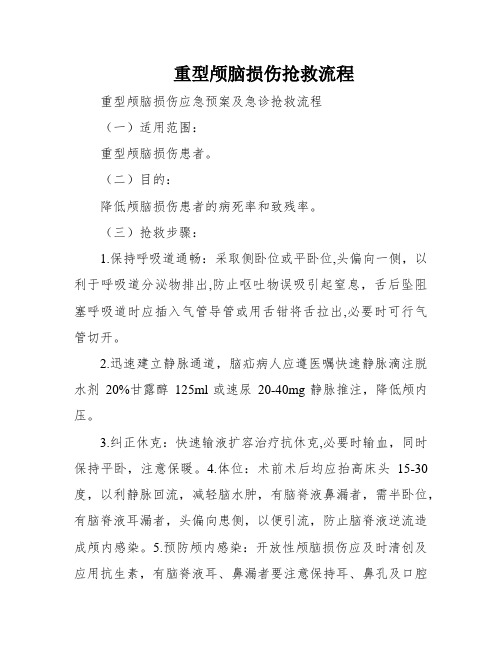
重型颅脑损伤抢救流程重型颅脑损伤应急预案及急诊抢救流程(一)适用范围:重型颅脑损伤患者。
(二)目的:降低颅脑损伤患者的病死率和致残率。
(三)抢救步骤:1.保持呼吸道通畅:采取侧卧位或平卧位,头偏向一侧,以利于呼吸道分泌物排出,防止呕吐物误吸引起窒息,舌后坠阻塞呼吸道时应插入气管导管或用舌钳将舌拉出,必要时可行气管切开。
2.迅速建立静脉通道,脑疝病人应遵医嘱快速静脉滴注脱水剂20%甘露醇125ml或速尿20-40mg静脉推注,降低颅内压。
3.纠正休克:快速输液扩容治疗抗休克,必要时输血,同时保持平卧,注意保暖。
4.体位:术前术后均应抬高床头15-30度,以利静脉回流,减轻脑水肿,有脑脊液鼻漏者,需半卧位,有脑脊液耳漏者,头偏向患侧,以便引流,防止脑脊液逆流造成颅内感染。
5.预防颅内感染:开放性颅脑损伤应及时清创及应用抗生素,有脑脊液耳、鼻漏者要注意保持耳、鼻孔及口腔的清洁,尽可能避免挖鼻孔、打喷噎和咳嗽,严禁阻塞,用水冲洗耳、鼻及经鼻吸痰和插胃管,以免引起逆行感染。
5.高热护理:体温高时应及时给予降温,保持体温在正常或接近正常范围内,可采用药物及物理降温两种方法,对中枢性高热多以物理降温为主,如酒精擦浴、冰袋降温,必要时进行低温冬眠疗法。
6.躁动病人谨慎使用镇静药,应由专人看护,给予适当约束,防止坠床及意外发生。
7.加强基础护理,对于昏迷病人要注意保暖,定时翻身拍背,清理呼吸道,预防坠积性肺炎。
8.完善各项检查:心电图、三大常规检查。
9.术前准备:头部备皮、合血、选用公道抗菌素皮试。
10.非手术患者做好根蒂根基照顾护士、皮肤照顾护士。
11.实时做好抢救护理记录。
12.及时请神经外科医师会诊同时协助转神经外科进一步治疗。
重型颅脑损伤抢救流程(一)
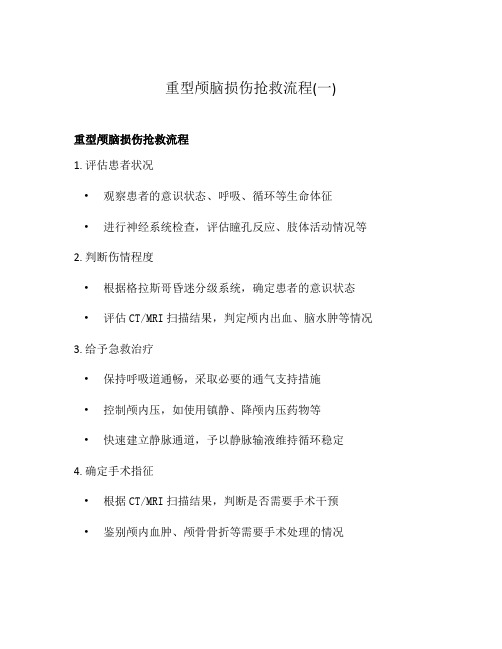
重型颅脑损伤抢救流程(一)
重型颅脑损伤抢救流程
1. 评估患者状况
•观察患者的意识状态、呼吸、循环等生命体征
•进行神经系统检查,评估瞳孔反应、肢体活动情况等2. 判断伤情程度
•根据格拉斯哥昏迷分级系统,确定患者的意识状态•评估CT/MRI扫描结果,判定颅内出血、脑水肿等情况3. 给予急救治疗
•保持呼吸道通畅,采取必要的通气支持措施
•控制颅内压,如使用镇静、降颅内压药物等
•快速建立静脉通道,予以静脉输液维持循环稳定
4. 确定手术指征
•根据CT/MRI扫描结果,判断是否需要手术干预
•鉴别颅内血肿、颅骨骨折等需要手术处理的情况
5. 进行手术抢救
•必要时进行颅骨开窗手术,减轻颅内压
•行开颅手术清除血肿,修复颅骨骨折等
6. 术后监护
•观察患者的生命体征,重点注意呼吸、血压和体温等指标
•进行神经系统监测,例如头颅CT、脑电图等
7. 康复治疗
•进行脑功能康复训练,包括语言、视力、肢体活动康复等
•提供心理支持,帮助患者及家属应对可能的认知和情绪问题8. 定期复查和随访
•定期进行头颅CT/MRI复查,评估患者恢复情况
•进行长期随访,了解患者的生活质量和认知功能恢复情况以上是重型颅脑损伤抢救的流程,医务人员需要密切观察患者的状况,并根据评估结果进行急救治疗、手术干预和康复治疗。
这些流程的执行将为患者的康复提供有力支持。
重型颅脑损伤应急预案及抢救流程
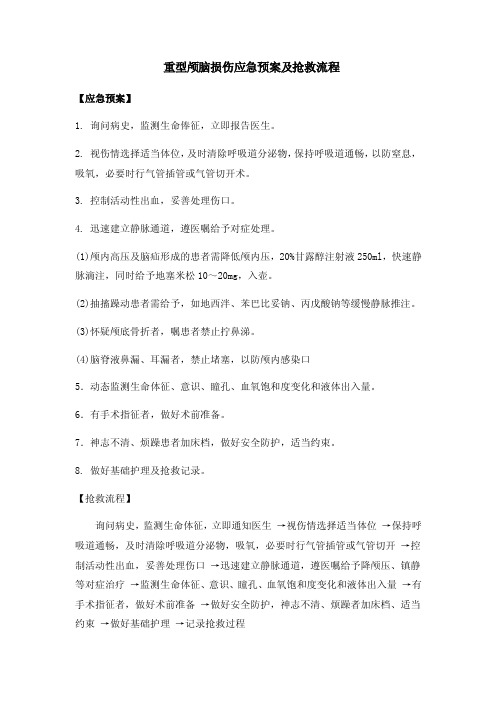
重型颅脑损伤应急预案及抢救流程
【应急预案】
1. 询问病史,监测生命俸征,立即报告医生。
2. 视伤情选择适当体位,及时清除呼吸道分泌物,保持呼吸道通畅,以防窒息,吸氧,必要时行气管插管或气管切开术。
3. 控制活动性出血,妥善处理伤口。
4. 迅速建立静脉通道,遵医嘱给予对症处理。
(1)颅内高压及脑疝形成的患者需降低颅内压,20%甘露醇注射液250ml,快速静脉滴注,同时给予地塞米松10~20mg,入壶。
(2)抽搐躁动患者需给予,如地西泮、苯巴比妥钠、丙戊酸钠等缓慢静脉推注。
(3)怀疑颅底骨折者,嘱患者禁止拧鼻涕。
(4)脑脊液鼻漏、耳漏者,禁止堵塞,以防颅内感染口
5.动态监测生命体征、意识、瞳孔、血氧饱和度变化和液体出入量。
6.有手术指征者,做好术前准备。
7.神志不清、烦躁患者加床档,做好安全防护,适当约束。
8. 做好基础护理及抢救记录。
【抢救流程】
询问病史,监测生命体征,立即通知医生→视伤情选择适当体位→保持呼吸道通畅,及时清除呼吸道分泌物,吸氧,必要时行气管插管或气管切开→控制活动性出血,妥善处理伤口→迅速建立静脉通道,遵医嘱给予降颅压、镇静等对症治疗→监测生命体征、意识、瞳孔、血氧饱和度变化和液体出入量→有手术指征者,做好术前准备→做好安全防护,神志不清、烦躁者加床档、适当约束→做好基础护理→记录抢救过程。
重型颅脑损伤处理流程
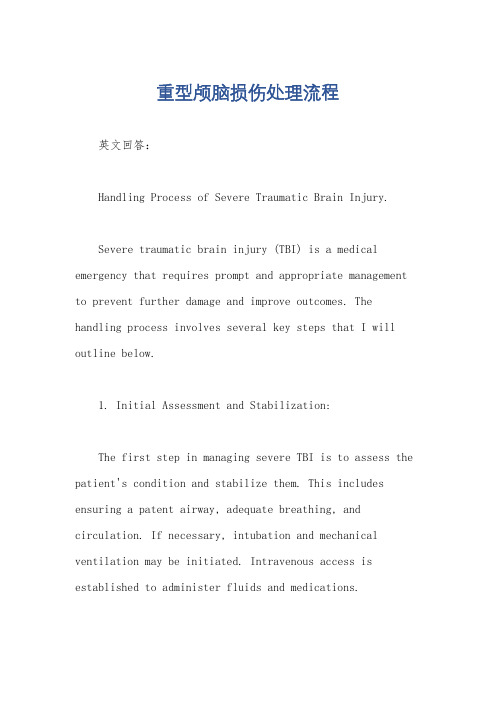
重型颅脑损伤处理流程英文回答:Handling Process of Severe Traumatic Brain Injury.Severe traumatic brain injury (TBI) is a medical emergency that requires prompt and appropriate management to prevent further damage and improve outcomes. The handling process involves several key steps that I will outline below.1. Initial Assessment and Stabilization:The first step in managing severe TBI is to assess the patient's condition and stabilize them. This includes ensuring a patent airway, adequate breathing, and circulation. If necessary, intubation and mechanical ventilation may be initiated. Intravenous access is established to administer fluids and medications.2. Imaging Studies:Imaging studies, such as a computed tomography (CT) scan, are crucial in evaluating the extent and location of brain injury. CT scans help identify any bleeding, swelling, or fractures that may require immediate surgical intervention.3. Intracranial Pressure (ICP) Monitoring:ICP monitoring is often necessary in severe TBI casesto guide management decisions. It helps assess the pressure inside the skull and provides valuable information aboutthe brain's perfusion and oxygenation. Various methods can be used to monitor ICP, including intraventricularcatheters or intraparenchymal monitors.4. Medical Management:Medical management of severe TBI involves maintaining adequate cerebral perfusion pressure (CPP) and oxygenation. This may include the administration of hypertonic saline ormannitol to reduce brain swelling, sedation to control agitation, and analgesics to manage pain. Seizure prophylaxis with antiepileptic drugs is also commonly initiated.5. Surgical Interventions:Surgery may be necessary to treat specific complications of severe TBI. This can include the evacuation of intracranial hematomas, decompressive craniectomy to relieve intracranial pressure, or the repair of skull fractures. Surgical interventions are typically performed by neurosurgeons.6. Neurocritical Care:Patients with severe TBI require specialized neurocritical care in an intensive care unit (ICU) setting. Close monitoring of vital signs, neurological status, and ICP is essential. Multidisciplinary teams, including neurologists, neurosurgeons, and critical care specialists, collaborate to optimize patient care and outcomes.7. Rehabilitation:After the acute phase of TBI management, rehabilitation plays a crucial role in promoting recovery and maximizing functional outcomes. Rehabilitation programs may include physical therapy, occupational therapy, speech therapy, and cognitive rehabilitation.中文回答:重型颅脑损伤处理流程。
重型颅脑损伤抢救流程
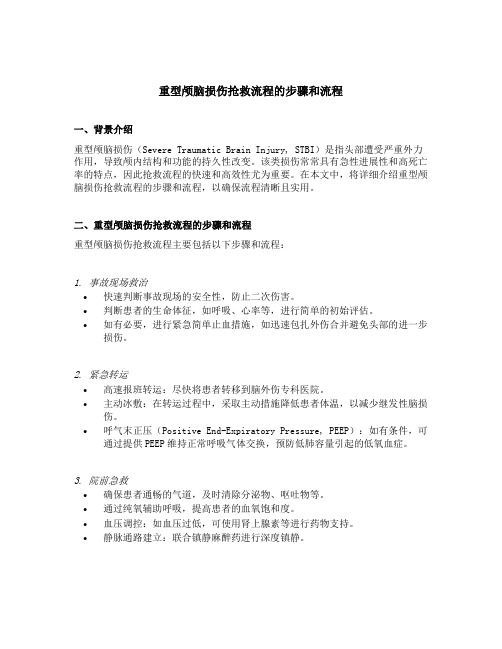
重型颅脑损伤抢救流程的步骤和流程一、背景介绍重型颅脑损伤(Severe Traumatic Brain Injury, STBI)是指头部遭受严重外力作用,导致颅内结构和功能的持久性改变。
该类损伤常常具有急性进展性和高死亡率的特点,因此抢救流程的快速和高效性尤为重要。
在本文中,将详细介绍重型颅脑损伤抢救流程的步骤和流程,以确保流程清晰且实用。
二、重型颅脑损伤抢救流程的步骤和流程重型颅脑损伤抢救流程主要包括以下步骤和流程:1. 事故现场救治•快速判断事故现场的安全性,防止二次伤害。
•判断患者的生命体征,如呼吸、心率等,进行简单的初始评估。
•如有必要,进行紧急简单止血措施,如迅速包扎外伤合并避免头部的进一步损伤。
2. 紧急转运•高速报班转运:尽快将患者转移到脑外伤专科医院。
•主动冰敷:在转运过程中,采取主动措施降低患者体温,以减少继发性脑损伤。
•呼气末正压(Positive End-Expiratory Pressure, PEEP):如有条件,可通过提供PEEP维持正常呼吸气体交换,预防低肺容量引起的低氧血症。
3. 院前急救•确保患者通畅的气道,及时清除分泌物、呕吐物等。
•通过纯氧辅助呼吸,提高患者的血氧饱和度。
•血压调控:如血压过低,可使用肾上腺素等进行药物支持。
•静脉通路建立:联合镇静麻醉药进行深度镇静。
4. 急诊科抢救•高浓度氧疗:以维持合理血氧水平。
•机械通气:以保证足够的氧供。
•气管切开:对患者气道受阻或高凝状态下进行插管。
•面罩睡眠呼吸机辅助通气。
•血流动力学支持:输液补充,纠正低血压和低组织灌注。
•支持治疗:维持电解质平衡和液体平衡。
5. 重症医学科接收和治疗•评估患者病情的严重程度,规划后续治疗方案。
•头颅CT扫描:确定脑损伤程度、定位和其他合并损伤情况。
•颅内压力监测:通过颅内压力监测装置,全天候监测颅内压力。
•药物治疗:–降颅内压:如甘露醇、呋塞米等。
–神经系统保护:如脑保护剂、抗炎药物等。
重症颅脑外伤昏迷患者抢救流程
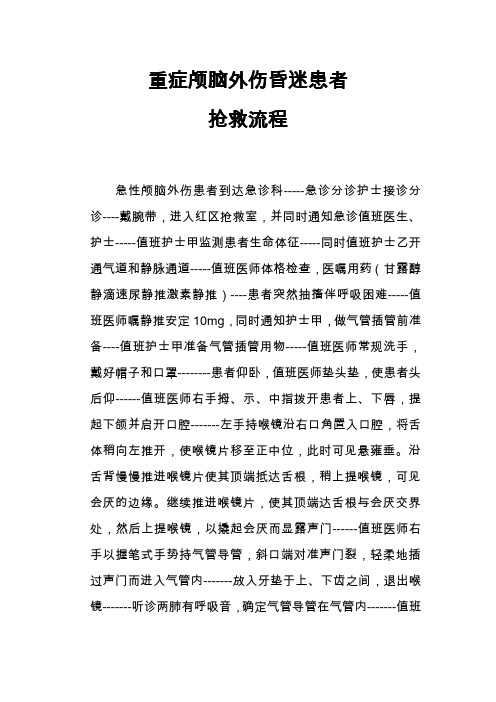
重症颅脑外伤昏迷患者抢救流程急性颅脑外伤患者到达急诊科-----急诊分诊护士接诊分诊----戴腕带,进入红区抢救室,并同时通知急诊值班医生、护士-----值班护士甲监测患者生命体征-----同时值班护士乙开通气道和静脉通道-----值班医师体格检查,医嘱用药(甘露醇静滴速尿静推激素静推)----患者突然抽搐伴呼吸困难-----值班医师嘱静推安定10mg,同时通知护士甲,做气管插管前准备----值班护士甲准备气管插管用物-----值班医师常规洗手,戴好帽子和口罩--------患者仰卧,值班医师垫头垫,使患者头后仰------值班医师右手拇、示、中指拨开患者上、下唇,提起下颌并启开口腔-------左手持喉镜沿右口角置入口腔,将舌体稍向左推开,使喉镜片移至正中位,此时可见悬雍垂。
沿舌背慢慢推进喉镜片使其顶端抵达舌根,稍上提喉镜,可见会厌的边缘。
继续推进喉镜片,使其顶端达舌根与会厌交界处,然后上提喉镜,以撬起会厌而显露声门------值班医师右手以握笔式手势持气管导管,斜口端对准声门裂,轻柔地插过声门而进入气管内-------放入牙垫于上、下齿之间,退出喉镜-------听诊两肺有呼吸音,确定气管导管在气管内-------值班护士甲妥善固定导管与牙垫------值班护士甲气管导管套囊注入适量空气(3~5 mL),使导管与气管壁密闭,防止呕吐物、口腔分泌物或血液流入气管------值班护士乙插管后吸痰,接气囊辅助人工呼吸------值班医师调整呼吸机参数-----接呼吸机机械通气-----值班护士乙整理用物,处置垃圾-------值班医师急请神经外科会诊-----神经外科医师提出会诊意见(考虑颅内出血,生命体征稳定,做颅脑CT,准备手术治疗)通知科室做好术前准备-----值班医师嘱病人进入重症患者绿色通道-----值班医师和值班护士甲护送病人做CT检查-------值班医师和值班护士乙护送病人进入神经外科病房(手术室)。
重度颅脑损伤抢救流程

重度颅脑损伤抢救流程概述本文档将介绍重度颅脑损伤抢救的流程,以帮助医务人员在处理相关紧急情况时能够采取正确且及时的措施。
抢救流程1. 急救措施:- 立即进行体格检查,评估患者的生命体征,并确保基本的生命支持。
- 确认患者的呼吸道通畅,维持氧气供应,必要时进行人工通气。
- 停止任何可能进一步造成损害的活动,如移动患者等。
- 控制出血,进行止血处理。
- 快速进行神经功能评估,以确定患者的神经系统损伤程度。
2. 影像检查:- 进行头部CT扫描,以评估颅脑损伤的程度和类型,并排除有关的颅内出血等情况。
3. 采取相应措施:- 根据患者的具体情况,决定是否进行手术干预。
- 如果需要手术,尽快安排手术,并通知手术团队准备。
- 如果不需要手术,进行综合治疗,包括药物治疗和相关协助措施。
4. 监测和观察:- 监测患者的生命体征,包括呼吸、心率、血压等,以及神经功能状况的动态变化。
- 密切观察患者的意识状态、瞳孔反应、肢体活动情况等,并进行相应的记录。
5. 护理措施:- 提供良好的护理环境,包括保持安静、减轻刺激、维持适宜的体温等。
- 配合营养师提供合适的饮食,满足患者的营养需求。
- 加强疼痛管理,确保患者的舒适度。
6. 康复和转归:- 合理制定康复计划,包括物理康复、语言康复、心理康复等,提高患者的功能恢复能力。
- 密切关注患者的康复进展和转归情况,及时调整护理计划。
- 给予患者和家属关于康复和转归的支持和指导。
结论重度颅脑损伤抢救流程的成功与否关乎患者的生命安全和康复情况。
医务人员应严格按照抢救流程操作,并根据患者的具体情况进行及时的调整和干预,以最大程度地降低风险,提高抢救成功率。
重度颅脑损伤患者应急预案及流程

重度颅脑损伤患者应急预案及流程下载提示:该文档是本店铺精心编制而成的,希望大家下载后,能够帮助大家解决实际问题。
文档下载后可定制修改,请根据实际需要进行调整和使用,谢谢!本店铺为大家提供各种类型的实用资料,如教育随笔、日记赏析、句子摘抄、古诗大全、经典美文、话题作文、工作总结、词语解析、文案摘录、其他资料等等,想了解不同资料格式和写法,敬请关注!Download tips: This document is carefully compiled by this editor. I hope that after you download it, it can help you solve practical problems. The document can be customized and modified after downloading, please adjust and use it according to actual needs, thank you! In addition, this shop provides you with various types of practical materials, such as educational essays, diary appreciation, sentence excerpts, ancient poems, classic articles, topic composition, work summary, word parsing, copy excerpts, other materials and so on, want to know different data formats and writing methods, please pay attention!1. 应急预案概述。
重度颅脑损伤患者的应急预案旨在有效地应对突发情况,最大限度地减少伤者的伤害,并保障其生命安全。
- 1、下载文档前请自行甄别文档内容的完整性,平台不提供额外的编辑、内容补充、找答案等附加服务。
- 2、"仅部分预览"的文档,不可在线预览部分如存在完整性等问题,可反馈申请退款(可完整预览的文档不适用该条件!)。
- 3、如文档侵犯您的权益,请联系客服反馈,我们会尽快为您处理(人工客服工作时间:9:00-18:30)。
重型颅脑损伤处理流程
英文回答:
Dealing with severe traumatic brain injury (TBI)
requires a well-structured and comprehensive approach to ensure the best possible outcome for the patient. As a healthcare professional with experience in managing such cases, I would like to share the general process and steps involved in handling a severe TBI.
1. Initial assessment and stabilization: The first step is to conduct a thorough assessment of the patient's condition, including vital signs, neurological status, and any associated injuries. This assessment helps in determining the severity of the TBI and identifying any immediate life-threatening issues that need to be addressed. Stabilization involves ensuring adequate oxygenation, maintaining blood pressure, and managing any other critical injuries.
2. Imaging and diagnostic tests: Once the patient is stabilized, imaging studies like CT scans or MRI are performed to assess the extent and location of the brain injury. These tests help in identifying any specific
lesions or bleeding that may require surgical intervention.
3. Neurosurgical interventions: In some cases, neurosurgical interventions such as decompressive craniectomy or hematoma evacuation may be necessary to relieve intracranial pressure or remove any blood clots or hematomas. These procedures aim to prevent further damage
to the brain and improve outcomes.
4. Intensive care management: Following surgery, the patient is usually admitted to the intensive care unit (ICU) for close monitoring and management. This includes maintaining optimal brain perfusion, controlling
intracranial pressure, and managing any complications that may arise. Medications such as diuretics or sedatives may
be used to control brain swelling or agitation.
5. Rehabilitation and recovery: As the patient's
condition stabilizes, a multidisciplinary team, including physiotherapists, occupational therapists, and speech therapists, works together to facilitate the patient's recovery. This involves various therapies and interventions aimed at improving motor skills, cognitive function, and speech abilities. The duration and intensity of rehabilitation depend on the severity of the brain injury and the individual's response to treatment.
6. Long-term management and support: Severe TBI often results in long-term physical, cognitive, and emotional challenges. Ongoing medical management, including regular follow-up visits, medication adjustments, and monitoring
for complications, is crucial. Additionally, providing emotional support and counseling to both the patient and their family members is essential in helping them cope with the long-term effects of the injury.
中文回答:
处理严重的颅脑损伤需要一个结构合理、全面的方法,以确保患者获得最佳的康复结果。
作为一个有经验的医护人员,我愿意分
享一下处理严重颅脑损伤的一般流程和步骤。
1. 初始评估和稳定,第一步是对患者的状况进行全面评估,包括生命体征、神经状况和任何相关的损伤。
这个评估有助于确定颅脑损伤的严重程度,并确定任何需要立即处理的危及生命的问题。
稳定包括确保足够的氧合、维持血压和处理任何其他重要的损伤。
2. 影像学和诊断测试,一旦患者稳定下来,会进行CT扫描或MRI等影像学检查,以评估颅脑损伤的程度和位置。
这些测试有助于确定任何需要手术干预的特定病变或出血。
3. 神经外科手术干预,在某些情况下,可能需要神经外科手术干预,例如减压颅骨切除术或血肿清除术,以减轻颅内压力或清除任何血块或血肿。
这些手术旨在防止进一步损伤脑部并改善预后。
4. 重症监护管理,手术后,患者通常被送入重症监护病房(ICU)接受密切监护和管理。
这包括维持脑灌注、控制颅内压力和处理可能出现的任何并发症。
可能会使用利尿剂或镇静剂等药物来控制脑部肿胀或激动。
5. 康复和恢复,随着患者状况的稳定,多学科团队,包括物理治疗师、职业治疗师和言语治疗师,共同努力促进患者的康复。
这
包括各种旨在改善运动技能、认知功能和言语能力的治疗和干预措施。
康复的持续时间和强度取决于颅脑损伤的严重程度和个体对治疗的反应。
6. 长期管理和支持,严重的颅脑损伤通常会导致长期的身体、认知和情绪挑战。
持续的医疗管理非常重要,包括定期复诊、调整药物和监测并发症。
此外,向患者及其家人提供情感支持和咨询对于帮助他们应对损伤的长期影响至关重要。
